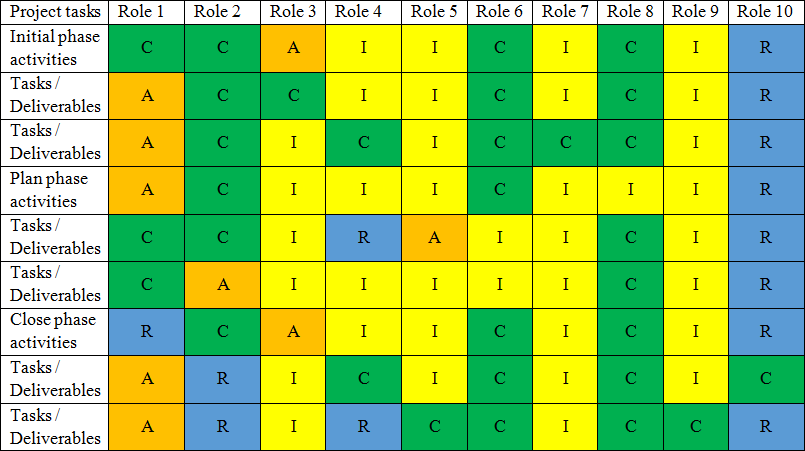
Introduction to RACI Matrix
Raci Matrix is a charting tool, and it stands for Responsible – Accountable – Consult – Inform. When it comes to monitoring the tasks of a complex project, the overall process gets tedious, not just because of the complexity but also because it becomes difficult and confusing to keep track of the tasks and the people involved in them.
What if I told you there is a quick chart fix?
Yes, there is a quick chart solution to this called the Raci Matrix.
What is RACI Matrix?
- Raci Matrix is a simple tool that is effective for improving the accountability and methodology used worldwide for a project, program, or any organizational change.
- Especially used by HR managers, business coaches, and top businesses to improve productivity, employee engagement, and business efficiency.
- In layman’s terms, it is a tool that enables you to identify who is responsible, accountable, consulted, or informed for every task that is carried out in a project.
Parameters Involved in RACI Matrix
Given below are the 4 parameters involved in a Raci Matrix:
1. Responsible
This is the person assigned to do the work. Decision-making lies in the hands of this person. They have to perform the tasks. At times there can be more than one person involved, but it is always advised to keep this countless to avoid complexity and confusion.
2. Accountable
This is the person who makes the final decision since they would have to be the owner of the task in the first place. Also, they would be accountable for the overall completion of the tasks or deliverables. They do not get involved in the work but are rather responsible for keeping track of the tasks until completion. Only one person is preferred to handle the accountability to ensure there is no confusion in multiple ownership of the tasks.
3. Consulted
This is the person who is consulted before a decision is taken. Here it can be an individual or a group who will provide the necessary information to complete the tasks of the project. A two-way communication needs to be ensured between the responsible and consulted person to avoid miscommunication in carrying out the tasks.
4. Informed
And lastly, this is the person who is informed before a decision is taken. These people will have a record of the latest updates of the tasks and the activities in progress. This person’s role doesn’t end with task completion, and they can be affected by the outcome of the tasks or deliverables. But they won’t be asked for feedback or review.
When do we Use RACI Matrix?
- When there is employee attrition, and you need to take quick and effective decisions for the company, especially with the new hiring.
- When there’s conflict about task ownership or decision-making.
- When you foresee that the decision-making or even the approval process can delay the project.
- When the project workload looks like it’s unevenly distributed.
Benefits
Given below are the benefits mentioned:
- Better communication and coordination between the various people involved in the task.
- Eliminates duplication of efforts.
- Team organization.
- Settles the conflicts in the project.
- Makes roles and responsibilities clear with proper guidelines.
- The team operates more smoothly.
- Identifies those avoiding responsibility.
- New team members are incorporated.
Guidelines
Given below are the guidelines mentioned:
- One Accountable would suffice per task.
- Ensure that each assignee has been informed about their assignment.
- Promote Teamwork.
- Keep the number of consultants to a minimum to save time.
- Update the Raci chart regularly, especially when employees don’t turn up to work so that there are no tasks left unattended. Task completion will have to be under the supervision of the accountable assignee.
- Keep the supervision of the tasks minimum. (PS- too many cooks spoil the broth)
How to Create RACI Matrix?
Further, we are going to simplify the Raci process by showing how to create a Raci Matrix.
Step 1: Identify the Projects Tasks
We can add the number of tasks using the “add task” tab. Also, we need to have the maintenance of the Raci Matrix as a task which is usually handled by the program manager or project manager.
We then need to add the roles or names of the participants who would successfully carry out the task. We can increase the number of participants by clicking on the “add participant” tab.
Step 2: Identifying the Project Roles
Step 3: Decide how to Chart the Matrix
Now we need to add the Raci codes – Responsible, Accountable, Consulted, or Informed, to respective tasks by clicking on the chart when a participant is included in a task.
Also, we can securely include or share the Raci chart with the team by selecting the permission level to be the view, edit/delete, and edit option. And this can be done for individual participants and not just limited to have a common access level set for the entire team. So with the link shared from export, the Raci chart can be downloaded as a Word or CSV document file.
Raci Matrix Example:
Raci Matrix Template:
So what are you waiting for? I am sure now that most of us are ready to start making our tasks more effective.
Go ahead and create a difference in your work methodology with Raci Matrix.
Recommended Articles
This has been a guide to RACI Matrix. Here we discussed the benefits, guidelines, parameters involved, and when to use Raci Matrix. You can also go through our other suggested articles to learn more –





